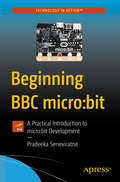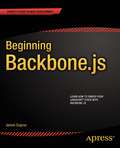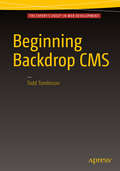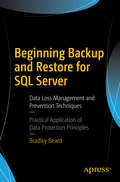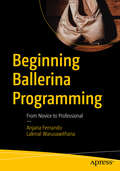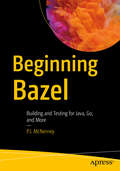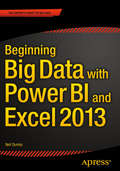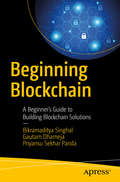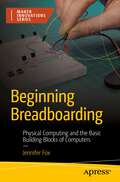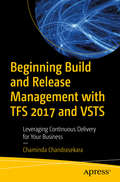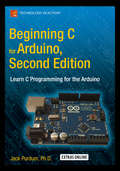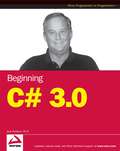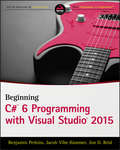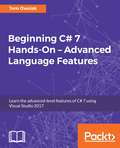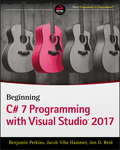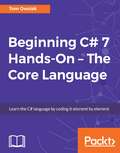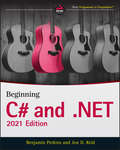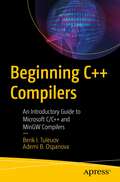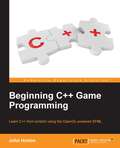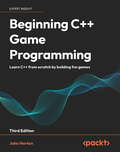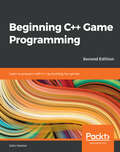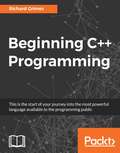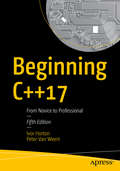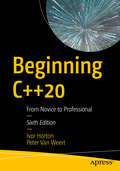- Table View
- List View
Beginning BBC micro:bit
by Pradeeka SeneviratneLearn essential concepts and techniques to build simple-to-advanced projects and overcome common programming challenges in micro:bit development. Beginning BBC micro:bit will take you through the complete features and capabilities of the micro:bit controller, enabling you to program and build your own projects. The uses are endless for the micro:bit and this books will help get you started on building your next project with this popular and easy-to-use microcontroller. You'll use online Python Editor and Mu Editor to build your own applications. Reviewed by the micro:bit developer team, this comprehensive guide also provides clean code examples to help you learn the key concepts behind the micro:bit API. What You’ll LearnWork with the various kits and accessoriesMaster the micro:bit development platform with easy to follow examples and clean codeBuild your own micro:bit applications using an online Python editor and Mu editorUse the on-board LED matrix, built-in buttons, I/O pins, accelerometer, and compassLearn how to connect and communicate with devices through I2C, SPI, and UARTBuild applications with music and speech librariesUse Local Persistent File System to store and manipulate filesBuild applications based on wired and radio networksUse micro:bit and micro:bit Blue appsWho This Book Is ForBeginners, those already experienced with electronics, and hobbyists at all levels looking to get started with a new microcontroller.
Beginning Backbone.js: Learn How To Enrich Your Javascript Stack With Backbone Js
by James SugrueBeginning Backbone. js is your step-by-step guide to learning and using the Backbone. js library in your web projects. Backbone. js is one of the most popular JavaScript libraries among web developers, used to create modular, single-page web apps. This book takes you from downloading Backbone. js and its dependencies all the way to using more advanced libraries to structure your application architecture, and everything in between. With a real-world, practical approach, you will learn how you can integrate Backbone. js into the center of your JavaScript stack, and create scalable applications. James Sugrue shows you how to implement all aspects of templating, work efficiently with RequireJS, and fully understand Grunt and all its plug-ins. Armed with this knowledge you'll be able to architect a continuous integration system that is key to real-world applications. With the explosion of JavaScript-based applications on the web, the need for more structured approaches to code management is more important than ever. Backbone. js helps create applications that separate models from views, enabling developers to avoid spaghetti code. Beginning Backbone. js will gently guide you into this amazingly powerful library, and help you ramp up to building professional applications. Integrate Backbone. js into your work today with this indispensable book. What you'll learn Learn the importance of MVC approaches in software development Learn why Backbone. js is so popular and how to integrate it into your JavaScript stack Understand core Backbone. js concepts such as models, views, routers, and events Test your application using the latest JavaScript testing tools Create build scripts using Grunt. js to simplify your build and deployment workflow Use additional libraries to build on the power of Backbone. js Avoid common beginner errors and code using best practices Who this book is for Beginning Backbone. js is for the web developer who is already confident with JavaScript, but who is keen to build larger, single-page web apps. If you want to introduce more structure, quality, and process to your web application using Backbone. js, and other leading JavaScript technologies, this is the book for you. Table of Contents Chapter 1: An Introduction To Backbone. js Chapter 2: Getting Object-Oriented Chapter 3: Backbone. js Model, View, and Collections Chapter 4: Templating with Underscore, Handlebars, and Mustache Chapter 5: Backbone. js Routers and Events Chapter 6: Backbone. js Start To Finish: Twitter App Example Chapter 7: The Backbone Ecosystem Chapter 8: Testing Your Backbone. js Application Chapter 9: Using Grunt for Your Build Process Chapter 10: Extending Backbone. js with Marionnette Chapter 11: Best Practices With Backbone. js Chapter 12: Creating A Manageable JavaScript Codebase
Beginning Backdrop CMS
by Todd TomlinsonLearn what Backdrop CMS is and how it fulfills the role of a content management system, along with how to install and configure it. This book teaches how to create and manage content, taxonomy, users, page layouts, and menus to get the best site possible. You'll also see how to install on shared hosting - which is a focus of the Backdrop CMS team - to make hosting your website affordable. Backdrop CMS has a very strong community, and Beginning Backdrop CMS shows you how to leverage Backdrop CMS's repository of contributed modules and themes to expand the functionality and look of your site, along with how to contribute your own material to the community. Beginning Backdrop CMS focuses on the user who is responsible for building, maintaining, and managing an organization's website and who is interested in Backdrop CMS's ability to meet their site's requirements. It covers why you should consider using a content management system when building a new web site. By reading this book, you will: Understand why you should use Backdrop CMS and the power of the platform. Build confidence in your ability to use Backdrop CMS. Gain the knowledge necessary to build, deploy, and manage web sites of moderate complexity on Backdrop CMS. Understand the process for migrating a Drupal 6 or 7 site to Backdrop CMS. What you'll learn How to install a basic Backdrop CMS web site from scratch How to create content in your new Backdrop CMS web site How to create blocks How to create and manage menus and users How to create and use layouts when creating pages on your site How to create a Backdrop CMS theme The basics of a Backdrop CMS module Who this book is for This book is for technical users who need to use Backdrop CMS to create websites using the platform, manage content, as well as developers who are new to the Backdrop CMS platform. The book is also targeted at organizations that currently use Drupal 6 or 7 and who wish to remain on the base architecture of those platforms as they move forward on Backdrop CMS.
Beginning Backup and Restore for SQL Server: Data Loss Management and Prevention Techniques
by Bradley BeardBe guided through the techniques to back up and restore databases and files in SQL Server. Multiple techniques are presented for ensuring the integrity and consistency of database backups, as well as the reliability and manageability of restoring from backups. In today’s data-driven world, the most important asset that a company has is its data. Data recovery strategies can be wide ranging; from the practically non-existent backup without verification to a very complex, distributed, and redundant system. An important objective for any database administrator is data loss prevention, and in a catastrophic data loss event, pre-defined data recovery techniques must be employed in order to get the databases back up and running efficiently and quickly.Using a tutorial method of teaching, Beginning Backup and Restore for SQL Server explores the many facets behind the principles of backing up and restoring data from your database, and then shows practical application methods for getting the work done quickly and correctly. This book is an essential guide toward discovering the correct path to protecting the data for your organization. What You'll LearnBe instructed on backup and restore techniques and principlesUnderstand the importance of a fully implemented backup plan in SQL Server AgentIntegrate backup and restore techniques into an existing environmentConsider space and time requirements for backup and restore operationsMaster the principles for common deployment typesWho This Book Is ForAdministrators who need to learn or refresh their knowledge of how to back up and restore SQL Server databases in various scenarios
Beginning Ballerina Programming: From Novice to Professional
by Anjana Fernando Lakmal WarusawithanaDiscover the Ballerina programming language for next-generation microservices and cloud-native application development. This book shows you that Ballerina is a cutting-edge programming language which incorporates many of the latest technological advancements in programming language theory. You'll learn variables and types, modules and functions, flow control, error handling, concurrency, I/O, cloud/network programming, persistence and data access, security and more. Additionally, Beginning Ballerina Programming introduces many foundation computer science topics along the way and doesn’t assume much prior knowledge. For example, when introducing transport-level security, you will get a brief introduction to public-key cryptography, how it is different from private-key cryptography, and why it is needed. This provides an added bonus for you to learn something new and general in computer science. After reading and using this book, you'll be proficient with Ballerina and cloud-first programming and be able to apply these concepts and techniques to your next cloud application developments. What You'll Learn · Start programming with Ballerina · Gain the basics of network communication and programming · Obtain a solid understanding of services/API development · Effective use of concurrency in programming · Learn the basics of information security and its applications · Persistent data storage and access Who This Book Is For Absolute beginners in computer programming: No prior experience with computer programming is expected. This can also be a reference book for experienced developers in other languages, who want to learn a modern programming language.
Beginning Bazel: Building and Testing for Java, Go, and More
by P.J. McNerneyDiscover Bazel, a new build and software test set of tools for today's programmers and developers. This book shows you how to speed up your builds and tests, and how to use Bazel in the context of your favorite programming language. You'll see that the languages and SDKs supported include Java, C++, Android, iOS, and Go. Beginning Bazel also shows you how scalable Bazel is for organizations, codebases, and continuous integration systems. It handles codebases of any size as well as multiple repos or a huge monorepo. Lastly, this book discusses how extensible Bazel is. You can easily add support for new languages and platforms with Bazel's extension language. As such, you'll be able to share and re-use language rules as they evolve in the Bazel community. What You Will LearnUse Bazel as a build toolTest software with Bazel Work with Java, C++, Android, iOS, Go, and other programming languagesRun Bazel on Linux, macOS, and WindowsScale and extend Bazel to other languages and platforms Who This Book Is ForExperienced programmers looking for alternative build/test tools.
Beginning Big Data with Power BI and Excel 2013: Big Data Processing and Analysis Using PowerBI in Excel 2013
by Neil DunlopIn Beginning Big Data with Power BI and Excel 2013, you will learn to solve business problems by tapping the power of Microsoft''s Excel and Power BI to import data from NoSQL and SQL databases and other sources, create relational data models, and analyze business problems through sophisticated dashboards and data-driven maps. While Beginning Big Data with Power BI and Excel 2013 covers prominent tools such as Hadoop and the NoSQL databases, it recognizes that most small and medium-sized businesses don''t have the Big Data processing needs of a Netflix, Target, or Facebook. Instead, it shows how to import data and use the self-service analytics available in Excel with Power BI. As you''ll see through the book''s numerous case examples, these tools--which you already know how to use--can perform many of the same functions as the higher-end Apache tools many people believe are required to carry out in Big Data projects. Through instruction, insight, advice, and case studies, Beginning Big Data with Power BI and Excel 2013 will show you how to: Import and mash up data from web pages, SQL and NoSQL databases, the Azure Marketplace and other sources. Tap into the analytical power of PivotTables and PivotCharts and develop relational data models to track trends and make predictions based on a wide range of data. Understand basic statistics and use Excel with PowerBI to do sophisticated statistical analysis--including identifying trends and correlations. Use SQL within Excel to do sophisticated queries across multiple tables, including NoSQL databases. Create complex formulas to solve real-world business problems using Data Analysis Expressions (DAX). What you''ll learn You will learn to: Use Excel and Power BI to do sophisticated data analytics on large data sets Import data from other sources into Excel Understand basic statistical techniques Analyze trends Perform complex calculation using DAX Present results using easy-to-understand visualizations such as maps Frame and solve real-world business problems through big data analysis Who this book is for Beginning Big Data with Power BI and Excel 2013 is designed for anyone who uses data analytics to make business decisions, especially those in small and medium-sized businesses. Table of Contents Introduction Chapter 1: Tools for Big Data Intake, Processing, and Analysis Chapter 2: Excel as a Database and Data Aggregator Chapter 3: Pivot Tables and Pivot Charts Chapter 4: Data Models Chapter 5: SQL in Excel Chapter 6: NoSQL Databases in Excel Chapter 7: Statistical Analysis in Excel Chapter 8: Data Analysis Expressions Chapter 9: Reports and Dashboards Chapter 10: Data Visualizations Chapter 11: Summary and Review
Beginning Blockchain: A Beginner's Guide to Building Blockchain Solutions
by Bikramaditya Singhal Gautam Dhameja Priyansu Sekhar PandaUnderstand the nuts and bolts of Blockchain, its different flavors with simple use cases, and cryptographic fundamentals. You will also learn some design considerations that can help you build custom solutions.Beginning Blockchain is a beginner’s guide to understanding the core concepts of Blockchain from a technical perspective. By learning the design constructs of different types of Blockchain, you will get a better understanding of building the best solution for specific use cases. The book covers the technical aspects of Blockchain technologies, cryptography, cryptocurrencies, and distributed consensus mechanisms. You will learn how these systems work and how to engineer them to design next-gen business solutions.What You'll LearnGet a detailed look at how cryptocurrencies workUnderstand the core technical components of BlockchainBuild a secured Blockchain solution from cryptographic primitivesDiscover how to use different Blockchain platforms and their suitable use casesKnow the current development status, scope, limitations, and future of BlockchainWho This Book Is ForSoftware developers and architects, computer science graduates, entrepreneurs, and anyone wishing to dive deeper into blockchain fundamentals. A basic understanding of computer science, data structure, and algorithms is helpful.
Beginning Breadboarding: Physical Computing and the Basic Building Blocks of Computers
by Jennifer FoxUsing fun, hands-on projects, learn what a circuit is and how it works! This book uses a common tool in electronics, the breadboard, to build your way to an understanding of circuits, circuit components, and the basics of computers. You'll master current, voltage, and resistance. With that you can control outputs like lights and motors as well as inputs like switches and sensors. You'll also discover the difference between analog and digital electrical signals while studying both electricity and computers. Dabble in electrical engineering, whether you are interested in building things with electronics or learning to program simple, physical systems. Build your own electronic projects to learn how electronics work. And also how computers store information and process requests. You'll work with simple, low-cost tools like conductive tape before developing up to working with breadboards and discovering the components to build more complex systems. With Beginning Breadboarding, makers of all ages and backgrounds can learn to build real-life physical computing systems and projects. Have fun building something with tangible results while learning all the theory you need to make new projects of your own!What You'll LearnRapidly prototype circuits with breadboardsUse common components to make simple electronic devicesShare electrical energy and control the flow of electricity through componentsWho This Book Is ForMakers, seeking a fun, hands-on introduction to technology, electronics, and computers. Those who have little to no knowledge of the subject, but want to learn electronics or know more about computers.
Beginning Build and Release Management with TFS 2017 and VSTS
by Chaminda ChandrasekaraMaster build and release management with Team Foundation Service and Visual Studio Team Services to facilitate the continuous delivery of software updates to your development team.You'll receive detailed, practical guidance on automating website deployments in Azure App Service, database deployments to Azure platform, Micro Services deployments in Azure Service Fabric, and more. Each deployment is structured with the aid of hands-on lessons in a given target environment designed to empower your teams to achieve successful DevOps. This book provides lessons on how to optimize build release management definitions using capabilities, such as task groups. With the help of practical scenarios, you’ll also learn how to diagnose and fix issues in automated builds and deployments. You’ll see how to enhance the capability of build and release management, using team services/TFS Marketplace extensions and writing your own extensions for any missing functionality via hands-on lessons.What You Will LearnAutomate deployment to Azure platform, including Web App Service, Azure SQL and Azure Service FabricTest automation integration with builds and deploymentsPerform Dynamic CRM deployment handling and package management with TFS/VSTSExamine requirement to production delivery traceability in practical terms Review cross platform build/deployment capabilities of TFS/VSTS. Who This Book Is ForBuild/Release Engineers, Configuration Managers, Software Developers, Test Automation Engineers, System Engineers, Software Architects and System/Production Support Engineers or anyone who handles and involves in the software delivery process.
Beginning C for Arduino: Learn C Programming for the Arduino
by Jack PurdumBeginning C for Arduino, Second Edition is written for those who have no prior experience with microcontrollers or programming but would like to experiment and learn both. Updated with new projects and new boards, this book introduces you to the C programming language, reinforcing each programming structure with a simple demonstration of how you can use C to control the Arduino family of microcontrollers. Author Jack Purdum uses an engaging style to teach good programming techniques using examples that have been honed during his 25 years of university teaching. Beginning C for Arduino, Second Edition will teach you: The C programming language How to use C to control a microcontroller and related hardware How to extend C by creating your own libraries, including an introduction to object-oriented programming During the course of the book, you will learn the basics of programming, such as working with data types, making decisions, and writing control loops. You'll then progress onto some of the trickier aspects of C programming, such as using pointers effectively, working with the C preprocessor, and tackling file I/O. Each chapter ends with a series of exercises and review questions to test your knowledge and reinforce what you have learned. What you'll learn The syntax of the C programming language as defined for the Arduino Tried and true coding practices (applicable to any programming language) How to design, code, and debug programs that drive Arduino microcontrollers How to extend the functionality of C How to integrate low cost, off-the-shelf, hardware shields into your own projects Who this book is for The book is aimed at a complete novice with no programming background. It assumes no prior programming or hardware design experience and is written for creative and curious people who would like to blend a software and hardware learning experience into a single, enjoyable endeavor. Table of Contents Introduction to Arduino Microcontrollers Arduino C Data Types Decision Making in C Program Loops Functions in C Storage Classes and Scope Introduction to Pointers Using Pointers Effectively I/O Operations The C Preprocessor A Gentle Introduction to Object-Oriented Programming Arduino Libraries Arduino I/O Appendix A - Suppliers Appendix B - Hardware Components
Beginning C# 3.0
by Jack PurdumLearn all the basics of C# 3.0 from Beginning C# 3.0: An Introduction to Object Oriented Programming, a book that presents introductory information in an intuitive format. If you have no prior programming experience but want a thorough, easy-to-understand introduction to C# and Object Oriented Programming, this book is an ideal guide. Using the tutorials and hands-on coding examples, you can discover tried and true tricks of the trade, understand design concepts, employ debugging aids, and design and write C# programs that are functional and that embody safe programming practices.
Beginning C# 6.0 Programming with Visual Studio 2015
by Perkins Jon D. Reid Jacob Vibe HammerGet started with Visual C# programming with this great beginner's guide Beginning C# 6.0 Programming with Visual Studio 2015 provides step-by-step directions for programming with C# in the .NET framework. Beginning with programming essentials, such as variables, flow control, and object-oriented programming, this authoritative text moves into more complicated topics, such as web and Windows programming and data access within both database and XML environments. After your introduction to each of the chapters, you are invited to apply your newfound knowledge in Try it Out sections, which reinforce learning and help you understand the practical applications of the new concepts you have explored. Through this approach, you can write useful programming code following each of the steps that you explore in this essential text. Discover the basics of programming with C#, such as variables, expressions, flow control, and functions Discuss how to keep your program running smoothly through debugging and error handling Understand how to navigate your way through key programming elements, such as classes, class members, collections, comparisons, and conversions Explore object-oriented programming, web programming, and Windows programming Beginning C# 6.0 Programming with Visual Studio 2015 is a fundamental resource for any programmers who are new to the C# language.
Beginning C# 7 Hands-On – Advanced Language Features
by Tom OwsiakAn advanced C# beginners guide to some of the tougher parts of the C# language! About This Book • Learn C#, Visual Studio, and object-oriented programming • Get practical examples of advanced C# language features so that you can easily master them yourself • Use the C# programming language to work generics and lambda expressions • Program C# and SQL Server 2014 • Get ready for your first MVC applications Who This Book Is For This book is for anyone who is interested in learning how to program the more advanced aspects of the C# language. Previous programming knowledge of C# is required, at least to the level of basic object-oriented programming. Readers can benefit from first reading Tom Owsiak's companion book, Beginning C# 7 Hands-On – The Core Language, as a preparation for the more advanced elements and techniques presented in this book. What You Will Learn • Learn C# advanced language elements and techniques • Discover advanced C# techniques with hands-on working examples • Build on your knowledge of OOP by using C# generics and lambda expressions • Work with C# and LINQ custom data types • Program C# and SQL Server 2017 to manage and query data • Create your first full MVC application In Detail Beginning C# 7 Hands-On – Advanced Language Features assumes that you've mastered the basic elements of the C# language and that you're now ready to learn the more advanced C# language and syntax, line by line, in a working Visual Studio environment. You'll learn how to code advanced C# language topics including generics, lambda expressions, and anonymous methods. You'll learn to use query syntax to construct queries and deploy queries that perform aggregation functions. Work with C# and SQL Server 2014 to perform complex joins and stored procedures. Explore advanced file access methods, and see how to serialize and deserialize objects – all by writing working lines of code that you can run within Visual Studio. This book is designed for beginner C# developers who have mastered the basics now, and anyone who needs a fast reference to using advanced C# language features in practical coding examples. You'll also take a look at C# through web programming with web forms. By the time you've finished this book, you'll know all the critical advanced elements of the C# language and how to program everything from C# generics to XML, LINQ, and your first full MVC web applications. These are the advanced building blocks that you can then combine to exploit the full power of the C# programming language, line by line. Style and approach A comprehensive book that blends theory with just the right amount of practical code implementations, to help you get up and running with the C# programming language and its advanced features. You'll also get to work with other tools and technologies that complement C# programming. Each core part of the C# language is coded as you learn, and code output is tested every time to verify the syntax is working as expected, so it's easy for you to learn directly from the working code examples. Advanced-level features of C# will be used to code and work through examples.
Beginning C# 7 Programming with Visual Studio 2017
by Jon D. Reid Benjamin Perkins Jacob Vibe HammerEasily get started programming using the ultra-versatile C# 7 and Visual Studio 2017 Beginning C# 7 Programming with Visual Studio 2017 is the beginner’s ultimate guide to the world’s most popular programming language. Whether you’re new to programming entirely, or just new to C#, there has never been a better time to get started. The new C# 7 and Visual Studio 2017 updates feature a number of new tools and features that streamline the workflow, simplify the code, and make it easier than ever to build high-quality apps. This book walks you through everything you need to know, starting from the very basics, to have you programming in no time. You’ll learn about variables, flow control, and object oriented programming, then move into Web and Windows programming as well as databases and XML. The companion website provides downloadable code examples, and practical Try It Out sections provide explicit, step-by-step instructions for writing your own useful, customizable code. C# 7 can be used to build Windows applications, program Windows 10, and write Web apps when used alongside ASP.NET. With programming skills becoming de rigueur in fields far beyond the tech world, C# 7 is a great place to start building versatile, helpful skills. This book gets you started quickly and easily with instruction from a master-team of C# programmers. Learn how to program using the world’s leading programming language Build smarter, faster apps using the latest features in C# 7 and Visual Studio 2017 Find and fix bugs sooner, saving headaches down the line Integrate with all .NET Core, Azure applications, cloud services, Docker containers, and more The world of programming can seem intimidating to a beginner, and the prospect of learning a whole new “language” can seem daunting. Beginning C# 7 Programming with Visual Studio 2017 demystifies the process and shows you how to bring your ideas to life.
Beginning C# Hands-On - The Core Language
by Tom OwsiakA C# beginners guide to the core parts of the C# language! About This Book • Learn C#, Visual Studio, and Object Oriented Programming • See practical examples of all the core C# language features so that you can easily master them yourself • Use the C# programming language to work with code and data, which can be applied to other programming languages as well • Complete a variety of programming assignments for hands-on practice, as you move through the course Who This Book Is For This book will appeal to anyone who is interested in learning how to program in C#. Previous programming experience will help you get through the initial sections with ease, although, it's not mandatory to possess any experience at all. What You Will Learn • Learn C#, Visual Studio, and object-oriented programming • Learn all the core C# language syntax with hands-on working examples • Learn everything from basic variable assignments to complex multidimensional arrays • Go through practical examples of all the core C# language features so that you can easily master them yourself • Use the C# programming language to work with code and data, which can be applied to other programming languages as well In Detail Beginning C# Hands-On - The Core Language teaches you core C# language and syntax in a working Visual Studio environment. This book covers everything from core language through to more advanced features such as object-oriented programming techniques. This book is for C# beginners who need a practical reference to core C# language features. You'll also gain a view of C# through web programming with web forms, so you'll learn HTML, basic CSS, and how to use a variety of controls, such as buttons and drop-down lists. You'll start with the fundamentals of C# and Visual Studio, including defining variables, interacting with users, and understanding data types, data conversions, and constants. You'll move on to checking conditions using if/else blocks, and see how to use loops to do things such as repeat blocks of code. After covering various operators to evaluate and assign control structures, you'll see how to use arrays to store collections of data. By the time you've finished the book, you'll know how to program the vital elements of the core C# language. These are the building blocks that you can then combine to build complex C# programs. Style and approach A comprehensive book that blends theory with just the right amount of practical code implementations, to help you get up and running with the C# programming language. You'll also get to work with other tools and technologies that complement C# programming. Each core part of the C# language is coded as you learn, and code output is tested every time to verify the syntax is working as expected, so it's easy for you to learn directly from the working code examples.
Beginning C# and .NET
by Jon D. Reid Benjamin PerkinsGet a running start to learning C# programming with this fun and easy-to-read guide As one of the most versatile and powerful programming languages around, you might think C# would be an intimidating language to learn. It doesn’t have to be! In Beginning C# and .NET: 2021 Edition, expert Microsoft programmer and engineer Benjamin Perkins and program manager Jon D. Reid walk you through the precise, step-by-step directions you’ll need to follow to become fluent in the C# language and .NET. Using the proven WROX method, you’ll discover how to understand and write simple expressions and functions, debug programs, work with classes and class members, work with Windows forms, program for the web, and access data. You’ll even learn about some of the new features included in the latest releases of C# and .NET, including data consumption, code simplification, and performance. The book also offers: Detailed discussions of programming basics, like variables, flow control, and object-oriented programming that assume no previous programming experience “Try it Out” sections to help you write useful programming code using the steps you’ve learned in the book Downloadable code examples from wrox.com Perfect for beginning-level programmers who are completely new to C#, Beginning C# and .NET: 2021 Edition is a must-have resource for anyone interested in learning programming and looking for a fun and intuitive place to start.
Beginning C++ Compilers: An Introductory Guide to Microsoft C/C++ and MinGW Compilers
by Berik I. Tuleuov Ademi B. OspanovaThis book focuses on how to install C/C++ compilers on Linux and Windows platforms in a timely and efficient way. Installing C/C++ compilers, especially Microsoft compilers, typically takes quite a lot of time because it comes with Microsoft Visual Studio for the vast majority of users. Installing Visual Studio requires usually about 40 GB of disk space and a large amount of RAM, so it is impossible to use weak hardware. The authors provide an easy way to deploy Microsoft C/C++ compiler: with no disk space headache and hardware resources lack. The method described saves significant time since software can even be deployed on removable devices, such as flash sticks, in an easy and portable way. It is achieved by using Enterprise Windows Driver Kit (EWDK), single big ISO image, which can be mounted as virtual device and used directly without any installation. EWDK contains everything from Visual Studio except IDE. EWDK also allows to use MASM64 (Microsoft Macro-Assembly) and C# compilers. With the aid of the MSBuild System, one can compile Visual Studio Projects (.vcxproj) and Solutions (.sln) without even using Visual Studio! Similarly, MinGW compilers can be deployed from 7z/zip archives, simply by unpacking into appropriate location. Both Microsoft C/C++ and MinGW compilers can be used as portable software—an approach that does not require administrative privileges at all. What you’ll learn Rapid installation of modern Microsoft C/C++ and MinGW compilers.How to prepare reusable and portable Microsoft C/C++ and MinGW compilers suite on removable media (flash stick, CD/DVD).How to use Microsoft C/C++ and MinGW compilers even on old/slow computers without standard installation.How to build under Windows the libraries originally designed for Unix-systems.Learn to run multiple versions of these compilers at the same time. Who This Book Is For Reader of all skills who wants to save time and efforts to start to work with C++. Also useful for scientists who are not familiar with software installation.
Beginning C++ Game Programming
by John HortonLearn C++ from scratch using the OpenGL-powered SFMLAbout This BookThis book offers a fun way to learn modern C++ programming while building exciting 2D gamesThis beginner-friendly guide offers a fast-paced but engaging approach to game developmentDive headfirst into building a wide variety of desktop games that gradually increase in complexityIt is packed with many suggestions to expand your finished games that will make you think critically, technically, and creativelyWho This Book Is ForThis book is for those who have no C++ programming knowledge whatsoever and want to learn to build games or just use games as a more engaging way to learn C++. If you have aspirations of one day publishing a game on Steam or just want to have a load of fun while learning C++, then this book was written for you.What You Will LearnGet to know C++ from scratch while simultaneously learning about building gamesMake C++ game coding appear like it is something that any determined person can doGet a competent level knowledge of C++ programming.Build exciting games with a wide range of featuresGet ready to go and build your own unique gamesIn DetailThis book is all about offering you a fun introduction to the world of game programming and C++. It will begin by teaching you the programming basics such as variables, loops, and conditions using game-like mini apps.We then move on to build actual working games. Throughout the course of the book, you will learn to build three different styles of games comprising a frantic two-button-tapper, a zombie survival/shooter, and a multiplayer platformer. While building these games, you will learn some more C++ programming concepts such as OOP and data storage/complexity. We'll end by creating a multiplayer shooter game and will also introduce you to some of the advanced capabilities of C++ such as networking and advanced OOP.As the games gradually increase in complexity, you will explore some of the advanced capabilities of C++ as well as some exciting new game programming techniques.
Beginning C++ Game Programming: Learn C++ from scratch by building fun games
by John HortonGet to grips with programming and game development techniques using C++ libraries and Visual Studio 2022 with this updated edition of the bestselling series.Key FeaturesCreate fun games in C++, with this up-to-date guide covering the latest features of C++20 and VS2022Build clones of popular games such as a Timberman clone, a Pong game, a Zombie Survival Shooter, and a platform endless runner gameDiscover tips to expand your finished games by thinking critically, technically, and creativelyBook DescriptionAlways dreamed of creating your own games? With the third edition of Beginning C++ Game Programming, you can turn that dream into reality! This beginner-friendly guide is updated and improved to include the latest features of VS 2022, SFML, and modern C++20 programming techniques. You'll get a fun introduction to game programming by building four fully playable games of increasing complexity. You'll build clones of popular games such as Timberman, Pong, a Zombie survival shooter, and an endless runner. The book starts by covering the basics of programming. You'll study key C++ topics, such as object-oriented programming (OOP) and C++ pointers and get acquainted with the Standard Template Library (STL). The book helps you learn about collision detection techniques and game physics by building a Pong game. As you build games, you'll also learn exciting game programming concepts such as vertex arrays, directional sound (spatialization), OpenGL programmable shaders, spawning objects, and much more. You’ll dive deep into game mechanics and implement input handling, levelling up a character, and simple enemy AI. Finally, you'll explore game design patterns to enhance your C++ game programming skills. By the end of the book, you'll have gained the knowledge you need to build your own games with exciting features from scratch.What you will learnSet up your game project in VS 2022 and explore C++ libraries such as SFMLBuild games in C++ from the ground up, including graphics, physics, and input handlingImplement core game concepts such as game animation, game physics, collision detection, scorekeeping, and game soundImplement automatically spawning objects and AI to create rich and engaging experiencesLearn advanced game development concepts, such as OpenGL shaders, texture atlases, and parallax backgroundsScale and reuse your game code with modern game programming design patternsWho this book is forThis book is perfect for you if you have no C++ programming knowledge, you need a beginner-level refresher course, or you want to learn how to build games or just use games as an engaging way to learn C++. Whether you aspire to publish a game (perhaps on Steam) or just want to impress friends with your creations, you'll find this book useful
Beginning C++ Game Programming: Learn to program with C++ by building fun games
by John HortonGet to grips with programming techniques and game development using C++ libraries and Visual Studio 2019Key FeaturesLearn game development and C++ with a fun, example-driven approachBuild clones of popular games such as Timberman, Zombie Survival Shooter, a co-op puzzle platformer, and Space InvadersDiscover tips to expand your finished games by thinking critically, technically, and creativelyBook DescriptionThe second edition of Beginning C++ Game Programming is updated and improved to include the latest features of Visual Studio 2019, SFML, and modern C++ programming techniques. With this book, you’ll get a fun introduction to game programming by building five fully playable games of increasing complexity. You’ll learn to build clones of popular games such as Timberman, Pong, a Zombie survival shooter, a coop puzzle platformer and Space Invaders. The book starts by covering the basics of programming. You’ll study key C++ topics, such as object-oriented programming (OOP) and C++ pointers, and get acquainted with the Standard Template Library (STL). The book helps you learn about collision detection techniques and game physics by building a Pong game. As you build games, you’ll also learn exciting game programming concepts such as particle effects, directional sound (spatialization), OpenGL programmable shaders, spawning objects, and much more. Finally, you’ll explore game design patterns to enhance your C++ game programming skills. By the end of the book, you’ll have gained the knowledge you need to build your own games with exciting features from scratch.What you will learnSet up your game development project in Visual Studio 2019 and explore C++ libraries such as SFMLExplore C++ OOP by building a Pong gameUnderstand core game concepts such as game animation, game physics, collision detection, scorekeeping, and game soundUse classes, inheritance, and references to spawn and control thousands of enemies and shoot rapid-fire machine gunsAdd advanced features to your game using pointers, references, and the STLScale and reuse your game code by learning modern game programming design patternsWho this book is forThis book is perfect for you if you have no C++ programming knowledge, you need a beginner-level refresher course, or you want to learn how to build games or just use games as an engaging way to learn C++. Whether you aspire to publish a game (perhaps on Steam) or just want to impress friends with your creations, you’ll find this book useful.
Beginning C++ Programming
by Richard GrimesModern C++ at your fingertips! About This Book • This book gets you started with the exciting world of C++ programming • It will enable you to write C++ code that uses the standard library, has a level of object orientation, and uses memory in a safe and effective way • It forms the basis of programming and covers concepts such as data structures and the core programming language Who This Book Is For A computer, an internet connection, and the desire to learn how to code in C++ is all you need to get started with this book. What You Will Learn • Get familiar with the structure of C++ projects • Identify the main structures in the language: functions and classes • Feel confident about being able to identify the execution flow through the code • Be aware of the facilities of the standard library • Gain insights into the basic concepts of object orientation • Know how to debug your programs • Get acquainted with the standard C++ library In Detail C++ has come a long way and is now adopted in several contexts. Its key strengths are its software infrastructure and resource-constrained applications, including desktop applications, servers, and performance-critical applications, not to forget its importance in game programming. Despite its strengths in these areas, beginners usually tend to shy away from learning the language because of its steep learning curve. The main mission of this book is to make you familiar and comfortable with C++. You will finish the book not only being able to write your own code, but more importantly, you will be able to read other projects. It is only by being able to read others' code that you will progress from a beginner to an advanced programmer. This book is the first step in that progression. The first task is to familiarize you with the structure of C++ projects so you will know how to start reading a project. Next, you will be able to identify the main structures in the language, functions, and classes, and feel confident being able to identify the execution flow through the code. You will then become aware of the facilities of the standard library and be able to determine whether you need to write a routine yourself, or use an existing routine in the standard library. Throughout the book, there is a big emphasis on memory and pointers. You will understand memory usage, allocation, and access, and be able to write code that does not leak memory. Finally, you will learn about C++ classes and get an introduction to object orientation and polymorphism. Style and approach This straightforward tutorial will help you build strong skills in C++ programming, be it for enterprise software or for low-latency applications such as games or embedded programming. Filled with examples, this book will take you gradually up the steep learning curve of C++.
Beginning C++17: From Novice To Professional
by Ivor Horton Peter Van WeertLearn how to program using the updated C++17 language. You'll start with the basics and progress through step-by-step examples to become a working C++ programmer. All you need are Beginning C++17 and any recent C++ compiler and you'll soon be writing real C++ programs. There is no assumption of prior programming knowledge.All language concepts that are explained in the book are illustrated with working program examples, and all chapters include exercises for you to test and practice your knowledge. Code downloads are provided for all examples from the text and solutions to the exercises.This latest edition has been fully updated to the latest version of the language, C++17, and to all conventions and best practices of so-called modern C++. Beginning C++17 also introduces the elements of the C++ Standard Library that provide essential support for the C++17 language. What You'll LearnDefine variables and make decisionsWork with arrays and loops, pointers and references, strings, and moreWrite your own functions, types, and operatorsDiscover the essentials of object-oriented programmingUse overloading, inheritance, virtual functions and polymorphismWrite generic function templates and class templates Get up to date with modern C++ features: auto type declarations, move semantics, lambda expressions, and moreExamine the new additions to C++17Who This Book Is ForProgrammers new to C++ and those who may be looking for a refresh primer on the C++17 programming language in general.
Beginning C++20 Game Programming - Second Edition
by John HortonThis book is perfect for you if you have no C++ programming knowledge, you need a beginner-level refresher course, or you want to learn how to build games or just use games as an engaging way to learn C++. Whether you aspire to publish a game (perhaps on Steam) or just want to impress friends with your creations, you’ll find this book useful.
Beginning C++20: From Novice to Professional
by Ivor Horton Peter Van WeertBegin your programming journey with C++ , starting with the basics and progressing through step-by-step examples that will help you become a proficient C++ programmer. This book includes new features from the C++20 standard such as modules, concepts, ranges, and the spaceship operator. All you need are Beginning C++20 and any recent C++ compiler and you'll soon be writing real C++ programs. There is no assumption of prior programming knowledge.All language concepts that are explained in the book are illustrated with working program examples, and all chapters include exercises for you to test and practice your knowledge. Free source code downloads are provided for all examples from the text and solutions to the exercises.This latest edition has been fully updated to the latest version of the language, C++20, and to all conventions and best practices of modern C++. Beginning C++20 also introduces the elements of the C++ Standard Library that provide essential support for the C++20 language. What You Will LearnBegin programming with the C++20 standardCarry out modular programming in C++Work with arrays and loops, pointers and references, strings, and moreWrite your own functions, types, and operatorsDiscover the essentials of object-oriented programmingUse overloading, inheritance, virtual functions, and polymorphismWrite generic function and class templates, and make them safer using concepts Learn the ins and outs of containers, algorithms, and rangesUse auto type declarations, exceptions, move semantics, lambda expressions, and much moreWho This Book Is ForProgrammers new to C++ and those who may be looking for a refresh primer on C++ in general.
